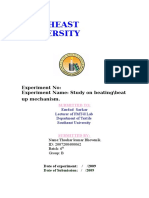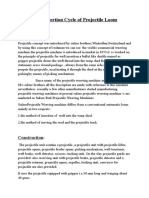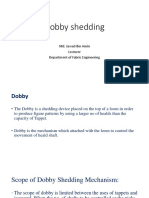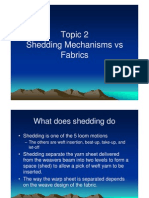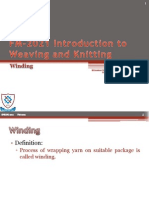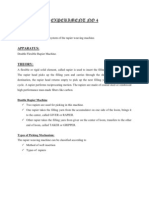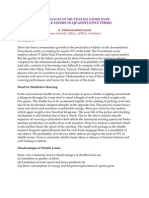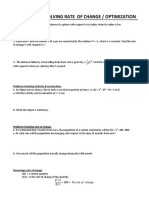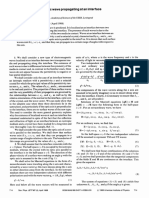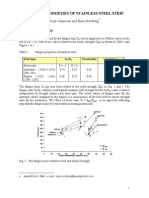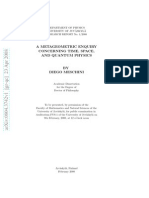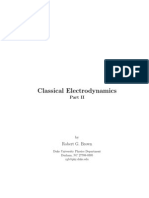0 ratings0% found this document useful (0 votes)
421 viewsPicking
Picking
Uploaded by
Sivakumar K- Picking is the process of inserting the weft yarn through the warp yarns during weaving. It can be done using various mechanisms like cone over-pick, cone under-pick, and side lever/shaft under-pick.
- Cone over-pick mechanisms use a picking cam on the bottom shaft to rotate a picking shaft and swing the picking stick over the loom to throw the shuttle. Cone under-pick mechanisms operate similarly but with the picking stick located below the shuttle trajectory.
- The type of picking mechanism used depends on factors like loom size, fabric weight, and desired production speed.
Copyright:
© All Rights Reserved
Available Formats
Download as PPT, PDF, TXT or read online from Scribd
Picking
Picking
Uploaded by
Sivakumar K0 ratings0% found this document useful (0 votes)
421 views17 pages- Picking is the process of inserting the weft yarn through the warp yarns during weaving. It can be done using various mechanisms like cone over-pick, cone under-pick, and side lever/shaft under-pick.
- Cone over-pick mechanisms use a picking cam on the bottom shaft to rotate a picking shaft and swing the picking stick over the loom to throw the shuttle. Cone under-pick mechanisms operate similarly but with the picking stick located below the shuttle trajectory.
- The type of picking mechanism used depends on factors like loom size, fabric weight, and desired production speed.
Original Title
picking
Copyright
© © All Rights Reserved
Available Formats
PPT, PDF, TXT or read online from Scribd
Share this document
Did you find this document useful?
Is this content inappropriate?
- Picking is the process of inserting the weft yarn through the warp yarns during weaving. It can be done using various mechanisms like cone over-pick, cone under-pick, and side lever/shaft under-pick.
- Cone over-pick mechanisms use a picking cam on the bottom shaft to rotate a picking shaft and swing the picking stick over the loom to throw the shuttle. Cone under-pick mechanisms operate similarly but with the picking stick located below the shuttle trajectory.
- The type of picking mechanism used depends on factors like loom size, fabric weight, and desired production speed.
Copyright:
© All Rights Reserved
Available Formats
Download as PPT, PDF, TXT or read online from Scribd
Download as ppt, pdf, or txt
0 ratings0% found this document useful (0 votes)
421 views17 pagesPicking
Picking
Uploaded by
Sivakumar K- Picking is the process of inserting the weft yarn through the warp yarns during weaving. It can be done using various mechanisms like cone over-pick, cone under-pick, and side lever/shaft under-pick.
- Cone over-pick mechanisms use a picking cam on the bottom shaft to rotate a picking shaft and swing the picking stick over the loom to throw the shuttle. Cone under-pick mechanisms operate similarly but with the picking stick located below the shuttle trajectory.
- The type of picking mechanism used depends on factors like loom size, fabric weight, and desired production speed.
Copyright:
© All Rights Reserved
Available Formats
Download as PPT, PDF, TXT or read online from Scribd
Download as ppt, pdf, or txt
You are on page 1of 17
Picking
• Picking is the second primary motion in weaving.
• The action of inserting weft yarn through the warp
yarns is called picking.
Objective of Picking
• To push the weft carrying element (shuttle, projectile
or rapier) or the weft yarn along the correct path
maintaining requisite velocity through the shed in
order to provide lateral sets of yarns in the fabric.
The functions of picking mechanism are:
1.To deliver the shuttle along the correct flight length.
2.To throw the shuttle at a predetermined speed.
Types of picking mechanism
• Conventional or negative mechanism
• Unconventional or positive mechanism
Conventional or negative mechanism
• It is normally used for shuttle loom
Unconventional or positive mechanism
• It is normally used for shuttless loom
Classification of Conventional or negative mechanism or Shuttle
Picking Mechanism
•Shuttle picking mechanisms are broadly classified as
Over pick mechanism
Cone over-pick mechanism
Under-pick mechanisms.
Side lever under-pick mechanisms
Side shaft under-pick mechanisms
Cone under-pick mechanisms.
• Parallel pick and
• Link pick.
Cone Over-Pick Mechanism
A picking cam attached to bottom shaft displaces the cone
(picking cone) which is attached with the upright picking shaft.
This causes rotation of the picking shaft.
As a result, the picking stick, which is attached to the
uppermost end of picking shaft, swing in a horizontal plane
over the loom and transmits the motion to shuttle through
picking strap and picker guided by a spindle.
Picking strap is a leather or polymeric belt which is flexible.
Here picker is constrained by the spindle to move in a straight
line which otherwise would have followed a path of arc.
Obviously, this restriction of path is achieved at the expense of
some energy.
• video\coneoverpickmech.mp4
Moreover, pairs of picking cam and follower installed at
either end of the loom have seldom ensured picking of
equal strength (force).
The cams responsible for impulsive rotation of the picking
stick receive motion through bottom shaft. However,
allied system of picking is having varying elastic behavior
(one of them is attached through a “stiff” short shaft while
that at the further end through a long “flexible” one).
All these warrant frequent adjustment of picking-strap or
picking cam and nose settings.
A system where a different cam and follower pairs are
used for each end makes the matter work enduringly with
standardized settings.
Features of Over Picking Mechanism:
1.Picking arm is over shuttle.
2.Suitable for narrow loom.
3.Higher picks per minute
4.Less power required.
5.Works more smoothly.
6.Shortening the picking strap and changing the
shape of the cam can increase picking force.
Cone Under-Pick Mechanism
Here also a picking cam attached to bottom shaft displaces
the cone turning the picking shaft (side shaft) located
horizontally.
The other end of the picking shaft is connected with upright
picking stick through the picking strap (lug strap).
This causes the picking stick to move in a vertical plane
and transmits the motion to shuttle by the picker attached at
the upper end of it.
In this system the picking stick and other appendages are
located below the shuttle trajectory while picking cams and
follower, as usual, below the loom and driven from bottom
shaft.
The system is naturally suitable for automatic
looms. Here picker slides over its spindle and
picking timing is regulated by cam adjustment
like in over pick motion.
An almost inextensible lug strap allows shuttle
speed adjustment by either raising or lowering
it around picking stick.
Absence of stretchable parts in under-pick
system ensures the retention of correct setting
over long period in contrast with the cone over-
pick mechanism.
Features of under picking mechanism:
1.Picker arm is placed under the race board.
2.Suitable for wider loom.
3.Under picking works less smoothly.
4.More direct action.
5.Rough in action.
6.More clean mechanism.
7.Consumes more power.
8.Used for heavy weight fabrics in silk and rayon
looms.
You might also like
- Chapter IV (LoomShedding)Document52 pagesChapter IV (LoomShedding)Prabhakaran J100% (2)
- Assignment On Under Picking MechanismDocument3 pagesAssignment On Under Picking MechanismZAyed100% (1)
- PickingDocument36 pagesPickingMoinul Islam Nasim100% (2)
- V-Bed Knitting (Manual) MachineDocument9 pagesV-Bed Knitting (Manual) MachineTESayedNo ratings yet
- Dobby SheddingDocument12 pagesDobby SheddingShanto Malo100% (1)
- .Knitting-1 Theory-Lecture-For Mid + FinalDocument33 pages.Knitting-1 Theory-Lecture-For Mid + FinalSanaullah MuradNo ratings yet
- Study of The Threading of Overlock MachineDocument4 pagesStudy of The Threading of Overlock Machineتحسین قائم خانی100% (1)
- Study On Cylinder Driving Mechanism & Working Principle of Single Lift Single Cylinder (SLSC) Jacquard Loom.Document4 pagesStudy On Cylinder Driving Mechanism & Working Principle of Single Lift Single Cylinder (SLSC) Jacquard Loom.Suza Ahmed Auporbo80% (5)
- Presentation of Cam Dobby and Heald Reversing MotionDocument12 pagesPresentation of Cam Dobby and Heald Reversing MotionSuraj RaghvNo ratings yet
- Group-6 LAB REPORT 2 TEX3104 ID 191-267-801Document7 pagesGroup-6 LAB REPORT 2 TEX3104 ID 191-267-801Minions MinionsNo ratings yet
- Study On Beat Up MechanismDocument3 pagesStudy On Beat Up MechanismtusharNo ratings yet
- Lesson 6 Noil Extraction Theory PDFDocument20 pagesLesson 6 Noil Extraction Theory PDFabhishekNo ratings yet
- Dobby Shedding Mechanism - Classification - Types - WorkingDocument9 pagesDobby Shedding Mechanism - Classification - Types - Workingakshay SinghNo ratings yet
- Jute SpinningDocument20 pagesJute SpinningAbdus Salam Ratan100% (1)
- TappetDocument10 pagesTappetoronno5No ratings yet
- Warp Stop-MotionsDocument21 pagesWarp Stop-MotionsJahid KhanNo ratings yet
- Weft Insertion Cycle of Projectile LoomDocument5 pagesWeft Insertion Cycle of Projectile LoomKrishna Patel Rb100% (1)
- DobbyDocument4 pagesDobbyLiz Aby100% (2)
- Fabric Manufacture Lab ManualDocument82 pagesFabric Manufacture Lab ManualPradyumna Narayan Singh100% (1)
- Shedding DobbiesDocument63 pagesShedding Dobbiesarunmythreyee100% (4)
- Picking in Projectile LoomDocument2 pagesPicking in Projectile LoomAniket Khot100% (2)
- Dobby Shedding MechanismDocument3 pagesDobby Shedding MechanismEhsaan Raahi RihaanNo ratings yet
- Box Changing MotionDocument25 pagesBox Changing MotionSweat TripathiNo ratings yet
- Figure: The Relanit Contra Knitting ActionDocument1 pageFigure: The Relanit Contra Knitting Actionmobarok2613100% (1)
- Textile Technology Internship ReportDocument24 pagesTextile Technology Internship Reportgunashekarkalluri100% (1)
- A. Tracer Fiber Technique: This Technique Involves Immersing A Yarn, Which Contains A VeryDocument23 pagesA. Tracer Fiber Technique: This Technique Involves Immersing A Yarn, Which Contains A VeryMagesh KumarNo ratings yet
- Keighley DobbyDocument10 pagesKeighley DobbySuraj Raghv100% (1)
- Double Lift Double Cylinder JacquardDocument11 pagesDouble Lift Double Cylinder Jacquardmahamudul islamNo ratings yet
- Draw FrameDocument50 pagesDraw FrameDev Narayan KushwahaNo ratings yet
- Chapter 2 DobbyDocument23 pagesChapter 2 DobbySyuhada AminuddinNo ratings yet
- 3.types of Feeler PDFDocument3 pages3.types of Feeler PDFEhsaan Raahi RihaanNo ratings yet
- Type of Shed and Tappet Shedding MechanismDocument43 pagesType of Shed and Tappet Shedding MechanismAfjal Hossain Sujan100% (1)
- Lecture 5 Dobby Shedding (JBA)Document17 pagesLecture 5 Dobby Shedding (JBA)Sajib Iglesias100% (1)
- Jacquard Shedding MechanismDocument10 pagesJacquard Shedding MechanismShanto MaloNo ratings yet
- Yarn Lea Strength Tester:: Prepared By-S. M. Masum AlamDocument3 pagesYarn Lea Strength Tester:: Prepared By-S. M. Masum AlamTouhidul HassanNo ratings yet
- FabricationDocument37 pagesFabricationShamim Hossain100% (1)
- Basic Warp Knitting PrincipleDocument8 pagesBasic Warp Knitting PrincipleTamanna Ahmed100% (1)
- 2.pirn Winding Machine (Main Parts & Yarn Path Diagram)Document10 pages2.pirn Winding Machine (Main Parts & Yarn Path Diagram)Ferdaus Hasan Bappi100% (1)
- Topic 2 Shedding MechanismsDocument28 pagesTopic 2 Shedding MechanismsMainul Islam100% (1)
- Temple To Hold The Fabric Width Way On The LoomDocument7 pagesTemple To Hold The Fabric Width Way On The LoomTejas pimpleNo ratings yet
- WindingDocument23 pagesWindingAmmar Naeem BhattiNo ratings yet
- Rapier WeftDocument14 pagesRapier WeftSarah Asghar100% (1)
- Patterning in Weft Knitting: Waqas AshrafDocument33 pagesPatterning in Weft Knitting: Waqas AshrafHifza khalidNo ratings yet
- 2.5 Pirn WindersDocument5 pages2.5 Pirn WindersCraig MartinNo ratings yet
- Roving Defects - FinalDocument6 pagesRoving Defects - FinalMohd MushahidNo ratings yet
- Backed Cloths StructuresDocument12 pagesBacked Cloths StructuresMina Samy abd el zaherNo ratings yet
- Yarn Lab ReportDocument6 pagesYarn Lab ReportYeasin ArafatNo ratings yet
- Weft Knitting - 2Document23 pagesWeft Knitting - 2Mina Samy abd el zaherNo ratings yet
- Let OffDocument3 pagesLet OffLondon StNo ratings yet
- Weaving Technology 3rd Sem Unit - II DHTTDocument59 pagesWeaving Technology 3rd Sem Unit - II DHTTSANJIT JANANo ratings yet
- Warp Way DefectsDocument11 pagesWarp Way Defectsharshal52855No ratings yet
- (1.2c) Auxiliary Mechanism-Weft Fork (Side)Document10 pages(1.2c) Auxiliary Mechanism-Weft Fork (Side)sukanya prasadNo ratings yet
- Advantages of Shuttleless LoomsDocument8 pagesAdvantages of Shuttleless LoomsTanzeel Areeb0% (1)
- WarpingDocument10 pagesWarpingKalyan Ray GuptaNo ratings yet
- Welcome To Our PresentationDocument40 pagesWelcome To Our PresentationAbdul AzizNo ratings yet
- Classification of Shuttle Picking MechanismDocument14 pagesClassification of Shuttle Picking MechanismSANJIT JANANo ratings yet
- Study On Take Up Mechanism: (Cotton Weaving)Document4 pagesStudy On Take Up Mechanism: (Cotton Weaving)Bhaskar MitraNo ratings yet
- PL Chapter 5Document8 pagesPL Chapter 5kaleabandebet7No ratings yet
- Plain Power LoomDocument4 pagesPlain Power LoomArunraj ArumugamNo ratings yet
- TwistDocument27 pagesTwistSivakumar KNo ratings yet
- Unit 1 Intelligent Textiles For Medical Applications An OverviewDocument44 pagesUnit 1 Intelligent Textiles For Medical Applications An OverviewSivakumar KNo ratings yet
- Unit 1 Functional GarmentsDocument60 pagesUnit 1 Functional GarmentsSivakumar KNo ratings yet
- Qbank Ietci 2019 2020 OddDocument4 pagesQbank Ietci 2019 2020 OddSivakumar KNo ratings yet
- Qbank FM II 2019-2020 EvenDocument4 pagesQbank FM II 2019-2020 EvenSivakumar KNo ratings yet
- Draw FrameDocument60 pagesDraw FrameSivakumar K100% (1)
- Garment DyeingDocument25 pagesGarment DyeingSivakumar KNo ratings yet
- Advanced SpinningDocument130 pagesAdvanced SpinningSivakumar K100% (5)
- Mathematical Tools 2Document12 pagesMathematical Tools 2divyanshubatta0No ratings yet
- Gizmo - VectorsDocument7 pagesGizmo - VectorsAllister LoboNo ratings yet
- Determination of The Acceleration Due To Gravity by Means of Simple PendulumDocument6 pagesDetermination of The Acceleration Due To Gravity by Means of Simple Pendulumarwa zeglamNo ratings yet
- Roye TrainingDocument3 pagesRoye TraininggottliebbassopNo ratings yet
- Actuators: Getting Started With Peas-Based Flapping-Wing Mechanisms For Micro Aerial SystemsDocument17 pagesActuators: Getting Started With Peas-Based Flapping-Wing Mechanisms For Micro Aerial SystemsArman AsgharpoorNo ratings yet
- SUB: Heat & Mass Transfer (EME 504) : Assignment-IDocument2 pagesSUB: Heat & Mass Transfer (EME 504) : Assignment-IdearsaswatNo ratings yet
- Open Channel EnergyDocument4 pagesOpen Channel Energyvtsh100No ratings yet
- Activity 13 IN SOUND WAVESDocument2 pagesActivity 13 IN SOUND WAVESKc Clyde Mendoza LavarejosNo ratings yet
- Problems Involving Rate of ChangeDocument5 pagesProblems Involving Rate of ChangePaolo NaguitNo ratings yet
- 50Q - WavesDocument10 pages50Q - WavesshobhasunilsinghNo ratings yet
- Building Period Formulas For Estimating Seismic DisplacementsDocument4 pagesBuilding Period Formulas For Estimating Seismic Displacementsfrrkh1No ratings yet
- Library GenesisDocument7 pagesLibrary GenesisJonathan AlmeidaNo ratings yet
- Chapter-18 Electromagnetic Induction (PG 325 To 358)Document30 pagesChapter-18 Electromagnetic Induction (PG 325 To 358)Mudit JainNo ratings yet
- Important Derivations of Physics, Class 12 - CBSE: R. K. Malik'S Newton Classes RanchiDocument11 pagesImportant Derivations of Physics, Class 12 - CBSE: R. K. Malik'S Newton Classes RanchiPadma kannaNo ratings yet
- 03 Russo & Viggiani KeynoteDocument20 pages03 Russo & Viggiani KeynotepierussoNo ratings yet
- Chapter III - TorsionDocument19 pagesChapter III - TorsionMostafa Essam Ezzat MahmoudNo ratings yet
- Jackson 8.4 Homework Problem SolutionDocument4 pagesJackson 8.4 Homework Problem SolutionAfzaalNo ratings yet
- HPSSRC Program FinalDocument40 pagesHPSSRC Program FinalFangxin HUNo ratings yet
- Engineering Mechanics: Dynamics: (3rd Edition)Document2 pagesEngineering Mechanics: Dynamics: (3rd Edition)george guerraNo ratings yet
- Mechanics of Rigid Bodies - 28oct2022Document10 pagesMechanics of Rigid Bodies - 28oct2022Kenneth SilvaNo ratings yet
- New Type of Electromagnetic Wave Propagating at An InterfaceDocument3 pagesNew Type of Electromagnetic Wave Propagating at An InterfaceskurilkinaNo ratings yet
- Conveyor Belt TestingDocument6 pagesConveyor Belt TestingNorberto A. GhiggiNo ratings yet
- PHYSICS 1st Period TESTDocument4 pagesPHYSICS 1st Period TESTAlphonso TulayNo ratings yet
- Standing Wave An Upright WaveDocument7 pagesStanding Wave An Upright WavekamiruddinNo ratings yet
- Fluid Mechanics Worksheet 5Document2 pagesFluid Mechanics Worksheet 5yousof elsgayedNo ratings yet
- Solar Sail Trajectory Optimization For Intercepting, Impacting, and Deflecting Near-Earth AsteroidsDocument18 pagesSolar Sail Trajectory Optimization For Intercepting, Impacting, and Deflecting Near-Earth AsteroidsAleks TorresNo ratings yet
- Fatigue PropertiesDocument10 pagesFatigue PropertiestekabiNo ratings yet
- Diego Meschini - A Metageometric Enquiry Concerning Time, Space, and Quantum PhysicsDocument285 pagesDiego Meschini - A Metageometric Enquiry Concerning Time, Space, and Quantum PhysicsOppekeeNo ratings yet
- Electrodynamics A4Document357 pagesElectrodynamics A4Abdugheni NiyazNo ratings yet
- 1.01 Introduction To Structural AnalysisDocument13 pages1.01 Introduction To Structural AnalysisMarapa SimonNo ratings yet










